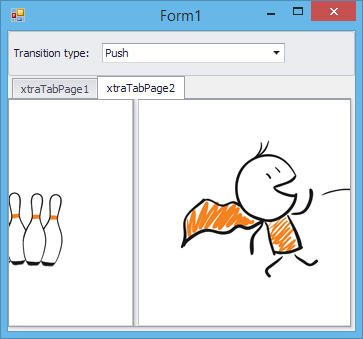TransitionManager.EndTransition() Method
Finalizes the current animated state transition.
Namespace: DevExpress.Utils.Animation
Assembly: DevExpress.Utils.v25.2.dll
NuGet Packages: DevExpress.Utils, DevExpress.Wpf.Core
Declaration
Remarks
The EndTransition method completes the animation that was initiated by the TransitionManager.StartTransition method. See TransitionManager to learn more.
Example
This example contains an XtraTabControl with two tabs. The TransitionManager component is used to animate switching between these tabs, using a certain animation effect (specified by the Transition Type combobox). Animated tab switching is initiated in the XtraTabControl.SelectedPageChanging event handler and is finished in the XtraTabControl.SelectedPageChanged event handler.Before the transition starts, it is created in the SelectedIndexChanged event of the combobox control. By default, the entire area occupied by the control is animated by the TransitionManager. In the example, the CustomTransition event is handled to exclude the tab region from animation.
The following image shows the state transition in progress:

using System;
using System.Collections.Generic;
using System.ComponentModel;
using System.Data;
using System.Drawing;
using System.Linq;
using System.Text;
using System.Windows.Forms;
using DevExpress.Utils.Animation;
using DevExpress.XtraEditors;
using DevExpress.XtraEditors.Controls;
namespace TransitionManagerSample {
public partial class Form1 : Form {
public Form1() {
InitializeComponent();
}
Control animatedControl;
private void xtraTabControl1_SelectedPageChanging(object sender, DevExpress.XtraTab.TabPageChangingEventArgs e) {
// Start the state transition when a page is about to be switched.
if (animatedControl == null) return;
transitionManager1.StartTransition(animatedControl);
}
private void xtraTabControl1_SelectedPageChanged(object sender, DevExpress.XtraTab.TabPageChangedEventArgs e) {
// Finish the transition after a page has been selected.
transitionManager1.EndTransition();
}
private void Form1_Load(object sender, EventArgs e) {
animatedControl = xtraTabControl1;
// Populate the ImageComboBox with available transition types.
imageComboBoxEdit1.Properties.Items.AddEnum(typeof(DevExpress.Utils.Animation.Transitions));
imageComboBoxEdit1.SelectedIndexChanged += imageComboBoxEdit1_SelectedIndexChanged;
imageComboBoxEdit1.SelectedIndex = 0;
}
BaseTransition CreateTransitionInstance(Transitions transitionType) {
switch (transitionType) {
case Transitions.Dissolve: return new DissolveTransition();
case Transitions.Fade: return new FadeTransition();
case Transitions.Shape: return new ShapeTransition();
case Transitions.Clock: return new ClockTransition();
case Transitions.SlideFade: return new SlideFadeTransition();
case Transitions.Cover: return new CoverTransition();
case Transitions.Comb: return new CombTransition();
default: return new PushTransition();
}
}
void imageComboBoxEdit1_SelectedIndexChanged(object sender, EventArgs e) {
ImageComboBoxEdit imComboBox = sender as ImageComboBoxEdit;
if (transitionManager1.Transitions[animatedControl] == null) {
// Add a transition, associated with the xtraTabControl1, to the TransitionManager.
Transition transition1 = new Transition();
transition1.Control = animatedControl;
transitionManager1.Transitions.Add(transition1);
}
// Specify the transition type.
DevExpress.Utils.Animation.Transitions trType = (DevExpress.Utils.Animation.Transitions)imComboBox.EditValue;
transitionManager1.Transitions[animatedControl].TransitionType = CreateTransitionInstance(trType);
}
// A custom easing function.
DevExpress.Data.Utils.IEasingFunction myEasingFunc = new DevExpress.Data.Utils.BackEase();
private void transitionManager1_CustomTransition(DevExpress.Utils.Animation.ITransition transition, DevExpress.Utils.Animation.CustomTransitionEventArgs e) {
// Set a clip region for the state transition.
e.Regions = new Rectangle[] { xtraTabPage1.Bounds };
// Specify a custom easing function.
e.EasingFunction = myEasingFunc;
}
}
}
Related GitHub Examples
The following code snippets (auto-collected from DevExpress Examples) contain references to the EndTransition() method.
Note
The algorithm used to collect these code examples remains a work in progress. Accordingly, the links and snippets below may produce inaccurate results. If you encounter an issue with code examples below, please use the feedback form on this page to report the issue.